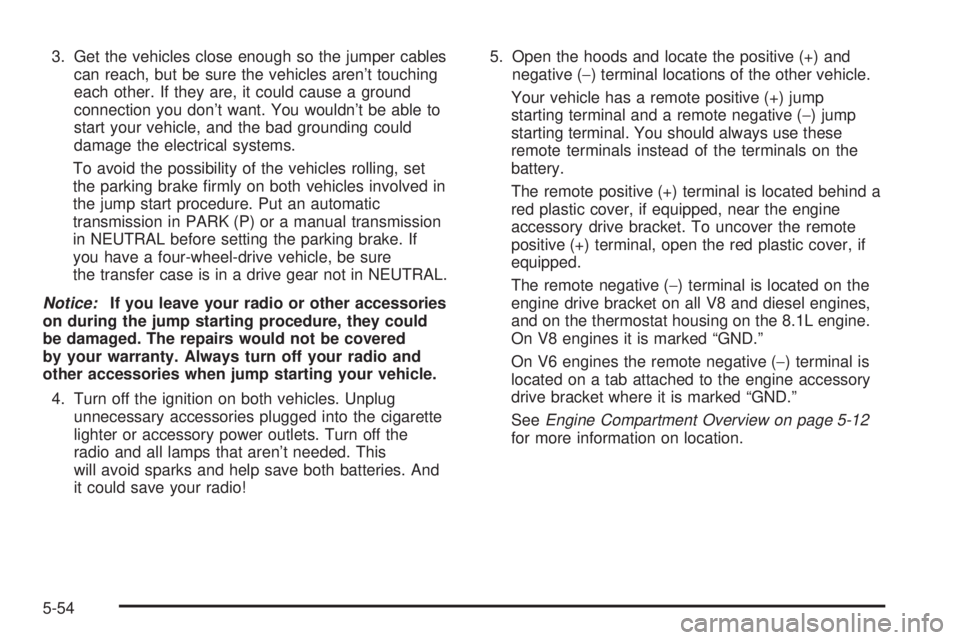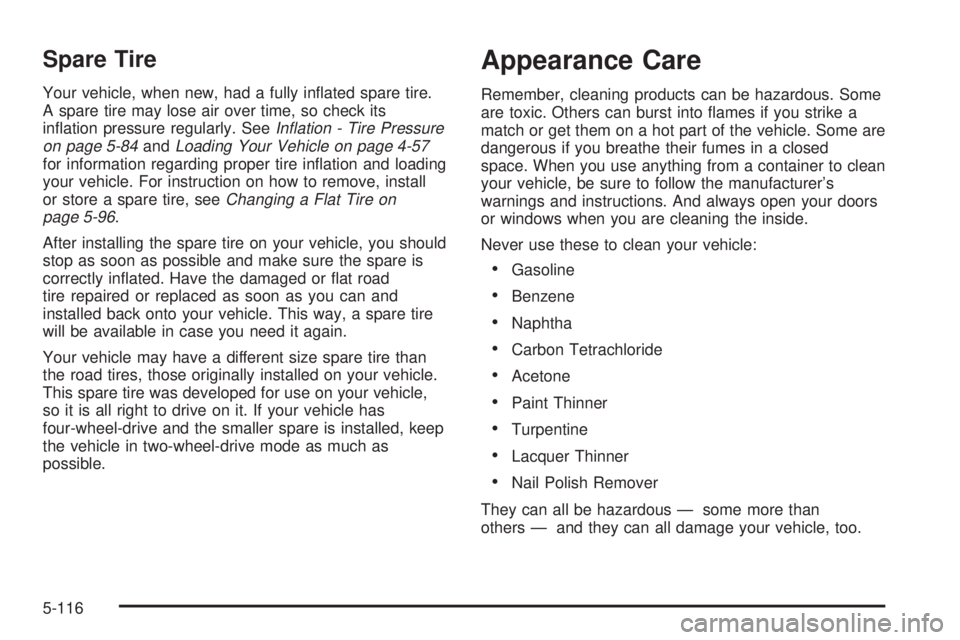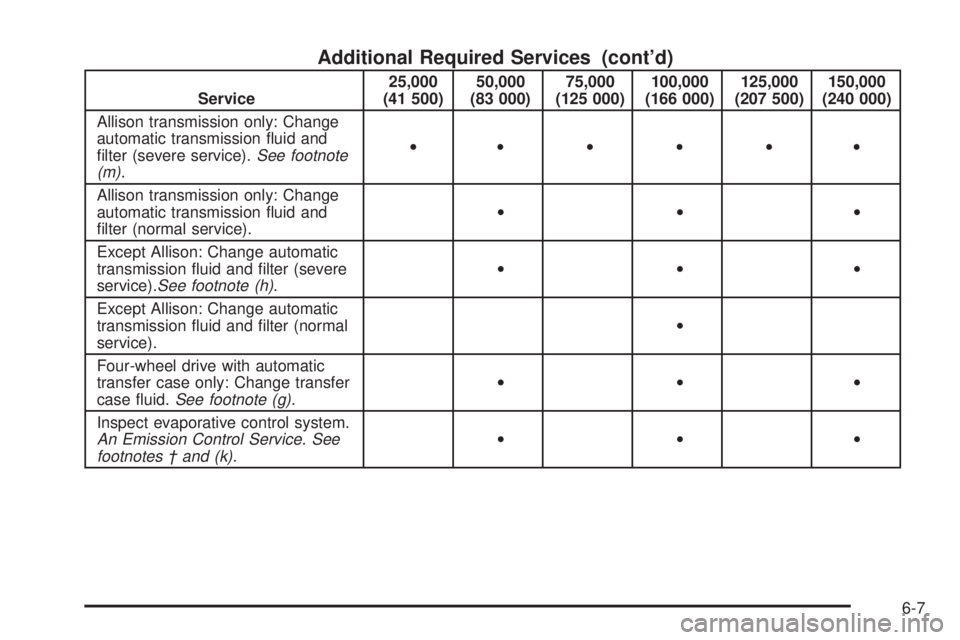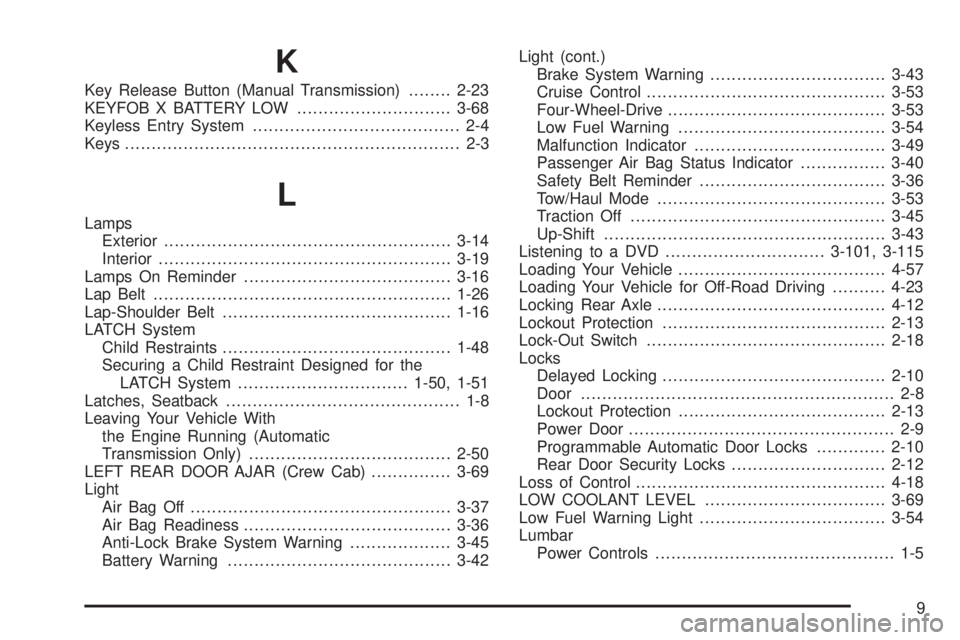2004 GMC SIERRA four wheel drive
[x] Cancel search: four wheel drivePage 454 of 588

3. Get the vehicles close enough so the jumper cables
can reach, but be sure the vehicles aren't touching
each other. If they are, it could cause a ground
connection you don't want. You wouldn't be able to
start your vehicle, and the bad grounding could
damage the electrical systems.
To avoid the possibility of the vehicles rolling, set
the parking brake ®rmly on both vehicles involved in
the jump start procedure. Put an automatic
transmission in PARK (P) or a manual transmission
in NEUTRAL before setting the parking brake. If
you have a four-wheel-drive vehicle, be sure
the transfer case is in a drive gear not in NEUTRAL.
Notice:If you leave your radio or other accessories
on during the jump starting procedure, they could
be damaged. The repairs would not be covered
by your warranty. Always turn off your radio and
other accessories when jump starting your vehicle.
4. Turn off the ignition on both vehicles. Unplug
unnecessary accessories plugged into the cigarette
lighter or accessory power outlets. Turn off the
radio and all lamps that aren't needed. This
will avoid sparks and help save both batteries. And
it could save your radio!5. Open the hoods and locate the positive (+) and
negative (-) terminal locations of the other vehicle.
Your vehicle has a remote positive (+) jump
starting terminal and a remote negative (-) jump
starting terminal. You should always use these
remote terminals instead of the terminals on the
battery.
The remote positive (+) terminal is located behind a
red plastic cover, if equipped, near the engine
accessory drive bracket. To uncover the remote
positive (+) terminal, open the red plastic cover, if
equipped.
The remote negative (-) terminal is located on the
engine drive bracket on all V8 and diesel engines,
and on the thermostat housing on the 8.1L engine.
On V8 engines it is marked ªGND.º
On V6 engines the remote negative (-) terminal is
located on a tab attached to the engine accessory
drive bracket where it is marked ªGND.º
See
Engine Compartment Overview on page 5-12for more information on location.
5-54
Page 460 of 588

Four-Wheel Drive
Lubricant checks in this section also apply to these
vehicles. However, there are two additional systems that
need lubrication.
Transfer Case
When to Check Lubricant
It is not necessary to regularly check transfer case ¯uid
unless you suspect there is a leak or you hear an
unusual noise. A ¯uid loss could indicate a problem.
Have it inspected and repaired.
How to Check Lubricant
Manual Transfer Case
5-60
Page 516 of 588

Spare Tire
Your vehicle, when new, had a fully in¯ated spare tire.
A spare tire may lose air over time, so check its
in¯ation pressure regularly. See
In¯ation - Tire Pressure
on page 5-84andLoading Your Vehicle on page 4-57for information regarding proper tire in¯ation and loading
your vehicle. For instruction on how to remove, install
or store a spare tire, see
Changing a Flat Tire on
page 5-96.
After installing the spare tire on your vehicle, you should
stop as soon as possible and make sure the spare is
correctly in¯ated. Have the damaged or ¯at road
tire repaired or replaced as soon as you can and
installed back onto your vehicle. This way, a spare tire
will be available in case you need it again.
Your vehicle may have a different size spare tire than
the road tires, those originally installed on your vehicle.
This spare tire was developed for use on your vehicle,
so it is all right to drive on it. If your vehicle has
four-wheel-drive and the smaller spare is installed, keep
the vehicle in two-wheel-drive mode as much as
possible.
Appearance Care
Remember, cleaning products can be hazardous. Some
are toxic. Others can burst into ¯ames if you strike a
match or get them on a hot part of the vehicle. Some are
dangerous if you breathe their fumes in a closed
space. When you use anything from a container to clean
your vehicle, be sure to follow the manufacturer's
warnings and instructions. And always open your doors
or windows when you are cleaning the inside.
Never use these to clean your vehicle:
·Gasoline
·Benzene
·Naphtha
·Carbon Tetrachloride
·Acetone
·Paint Thinner
·Turpentine
·Lacquer Thinner
·Nail Polish Remover
They can all be hazardous Ð some more than
others Ð and they can all damage your vehicle, too.
5-116
Page 527 of 588

Fuses Usage
RR Wiper Not Used
SEO ACCYSpecial Equipment Option
Accessory
WS WPR Windshield Wipers
TBC ACCYTruck Body Controller
Accessory
IGN 3 Ignition, Heated Seats
4WDFour-Wheel Drive System,
Auxiliary Battery
Fuses Usage
HTR A/C Climate Control System
LOCK (Relay)Power Door Lock Relay
(Lock Function)
HVAC 1 Climate Control System
L DOORDriver's Door Harness
Connection
CRUISECruise Control, Power Take
Off (PTO)
UNLOCK (Relay)Power Door Lock Relay
(Unlock Function)
RR FOG LP Not Used
BRAKE Anti-Lock Brake System
DRIVER UNLOCKPower Door Lock Relay
(Driver's Door Unlock
Function)
IGN 0 TCM
TBC IGN 0 Truck Body Controller
VEH CHMSLVehicle and Trailer High
Mounted Stoplamp
LT TRLR ST/TRN Left Turn Signal/Stop Trailer
LT TRNLeft Turn Signals and
Sidemarkers
VEH STOPVehicle Stoplamps, Brake
Module, Electronic Throttle
Control Module
RT TRLR ST/TRN Right Turn Signal/Stop Trailer
5-127
Page 539 of 588

Using Your Maintenance Schedule
We at General Motors want to help you keep your vehicle
in good working condition. But we do not know exactly
how you will drive it. You may drive very short distances
only a few times a week. Or you may drive long distances
all the time in very hot, dusty weather. You may use your
vehicle in making deliveries. Or you may drive it to work,
to do errands or in many other ways.
Because of all the different ways people use their
vehicles, maintenance needs vary. You may need more
frequent checks and replacements. So please read
the following and note how you drive. If you have any
questions on how to keep your vehicle in good condition,
see your GM Goodwrench dealer.
This schedule is for vehicles that:
·carry passengers and cargo within recommended
limits. You will ®nd these limits on the tire and
loading information label. See
Loading Your Vehicle
on page 4-57.
·are driven on reasonable road surfaces within legal
driving limits.
·are driven off-road in the recommended manner.
See
Off-Road Driving with Your Four-Wheel-Drive
Vehicle on page 4-20.
·use the recommended fuel. SeeGasoline Octane
on page 5-4
.The services in
Scheduled Maintenance on page 6-4should be performed when indicated. SeeAdditional
Required Services on page 6-6andMaintenance
Footnotes on page 6-8for further information.
{CAUTION:
Performing maintenance work on a vehicle can
be dangerous. In trying to do some jobs, you
can be seriously injured. Do your own
maintenance work only if you have the
required know-how and the proper tools and
equipment for the job. If you have any doubt,
see your GM Goodwrench dealer to have a
quali®ed technician do the work.
Some maintenance services can be complex.
So, unless you are technically quali®ed and have the
necessary equipment, you should have your
GM Goodwrench dealer do these jobs.
When you go to your GM Goodwrench dealer for your
service needs, you will know that GM-trained and
supported service technicians will perform the work
using genuine GM parts.
If you want to get service information, see
Service
Publications Ordering Information on page 7-12.
6-3
Page 543 of 588

Additional Required Services (cont'd)
Service25,000
(41 500)50,000
(83 000)75,000
(125 000)100,000
(166 000)125,000
(207 500)150,000
(240 000)
Allison transmission only: Change
automatic transmission ¯uid and
®lter (severe service).
See footnote
(m).······
Allison transmission only: Change
automatic transmission ¯uid and
®lter (normal service).···
Except Allison: Change automatic
transmission ¯uid and ®lter (severe
service).
See footnote (h).···
Except Allison: Change automatic
transmission ¯uid and ®lter (normal
service).·
Four-wheel drive with automatic
transfer case only: Change transfer
case ¯uid.
See footnote (g).···
Inspect evaporative control system.
An Emission Control Service. See
footnotes ² and (k).···
6-7
Page 577 of 588

Fluid (cont.)
Windshield Washer......................................5-46
FM Stereo....................................................3-129
Fog Lamps....................................................3-17
Folding the Rear Seat....................................... 1-9
Following Distance..........................................4-92
Four-Wheel Drive....................................2-35, 5-60
Four-Wheel-Drive Light....................................3-53
Front Axle......................................................5-61
Front Axle Locking Feature...............................2-35
Front Reading Lamps......................................3-19
Front Storage Area.........................................2-67
Fuel............................................................... 5-4
Additives...................................................... 5-6
California Fuel.............................................. 5-5
Filling a Portable Fuel Container..................... 5-9
Filling Your Tank........................................... 5-7
Fuels in Foreign Countries.............................. 5-6
Gage.........................................................3-54
Gasoline Octane........................................... 5-4
Gasoline Speci®cations.................................. 5-5
Low Warning Light.......................................3-54
Fuel Information Button....................................3-58
FUEL LEVEL LOW.........................................3-68
Fuses
Fuses and Circuit Breakers.........................5-126
Windshield Wiper.......................................5-126G
Gage
Engine Coolant Temperature.........................3-46
Fuel..........................................................3-54
Oil Pressure...............................................3-52
Speedometer..............................................3-35
Tachometer.................................................3-35
Transmission Temperature.............................3-47
Voltmeter Gage...........................................3-42
Gasoline
Octane........................................................ 5-4
Speci®cations............................................... 5-5
Getting Familiar with Off-Road Driving................4-24
Glove Box.....................................................2-66
GM Mobility Program for Persons with
Disabilities.................................................... 7-5
H
Hazard Warning Flashers................................... 3-6
Head Restraints............................................... 1-8
Headlamp High/Low-Beam Changer.................... 3-9
Headlamps....................................................5-64
Bulb Replacement.......................................5-64
7
Page 579 of 588

K
Key Release Button (Manual Transmission)........2-23
KEYFOB X BATTERY LOW.............................3-68
Keyless Entry System....................................... 2-4
Keys............................................................... 2-3
L
Lamps
Exterior......................................................3-14
Interior.......................................................3-19
Lamps On Reminder.......................................3-16
Lap Belt........................................................1-26
Lap-Shoulder Belt...........................................1-16
LATCH System
Child Restraints...........................................1-48
Securing a Child Restraint Designed for the
LATCH System................................1-50, 1-51
Latches, Seatback............................................ 1-8
Leaving Your Vehicle With
the Engine Running (Automatic
Transmission Only)......................................2-50
LEFT REAR DOOR AJAR (Crew Cab)...............3-69
Light
Air Bag Off .................................................3-37
Air Bag Readiness.......................................3-36
Anti-Lock Brake System Warning...................3-45
Battery Warning..........................................3-42Light (cont.)
Brake System Warning.................................3-43
Cruise Control.............................................3-53
Four-Wheel-Drive.........................................3-53
Low Fuel Warning.......................................3-54
Malfunction Indicator....................................3-49
Passenger Air Bag Status Indicator................3-40
Safety Belt Reminder...................................3-36
Tow/Haul Mode...........................................3-53
Traction Off................................................3-45
Up-Shift.....................................................3-43
Listening to a DVD..............................3-101, 3-115
Loading Your Vehicle.......................................4-57
Loading Your Vehicle for Off-Road Driving..........4-23
Locking Rear Axle...........................................4-12
Lockout Protection..........................................2-13
Lock-Out Switch.............................................2-18
Locks
Delayed Locking..........................................2-10
Door........................................................... 2-8
Lockout Protection.......................................2-13
Power Door.................................................. 2-9
Programmable Automatic Door Locks.............2-10
Rear Door Security Locks.............................2-12
Loss of Control...............................................4-18
LOW COOLANT LEVEL..................................3-69
Low Fuel Warning Light...................................3-54
Lumbar
Power Controls............................................. 1-5
9